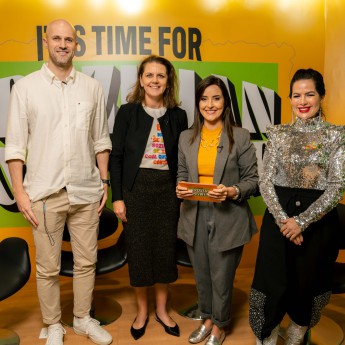Footwear sector modifies reality in Brazilian cities
The Brazilian footwear industry, which employs more than 260,000 people, moves the economy of the cities in which it is inserted
2021-11-11 | By Brazilian Footwear
 Reality in Brazilian cities
Reality in Brazilian cities
Present with economic strength in ten Brazilian states, the national footwear sector directly employs more than 260 thousand people, having a direct impact on economic and social development. In smaller cities, the importance becomes even greater, transforming realities and, consequently, increasing human development rates.
The CEO of Abicalçados, Haroldo Ferreira, highlights that many Brazilian cities have come to exist on the economic map due to the footwear sector. "Social gains are not only in the footwear sector, which as everyone knows is labor intensive. When a factory settles in a city, they go after inns, restaurants, supermarkets, pharmacies and commerce in general. It moves the entire economy", evaluates the executive.
The economic movement generated from the installation of a footwear industry is felt not only with the emergence of new businesses, but also from development indicators. One of them is the Human Development Index (HDI), established by the United Nations (UN) to measure the development of societies in issues such as education, health, income. In this way, it reflects the importance of the footwear industry for the cities where it is inserted. In some, the HDI doubled after the installation of the factories, which in addition to jobs, generated development through increased infrastructure and investments.
Vulcabras: social and economic development in the Northeast
With factories in Itapetinga/Bahia, and Horizonte/Ceará, the Vulcabras group is one of the most popular in Brazil, directly employing more than 16 thousand people. The company's CEO, Pedro Bartelle, points out that the economic and social impact on communities around the factories is significant. "The HDI of these regions is up to four times higher than the national average. In these cities, the footwear industry is propelling not only the economic development of an entire region, but also the personal and educational development of the people of the community”, evaluates the businessman. The numbers corroborate.
In 1996, when Vulcabras arrived in Horizonte, the HDI of the city was 0.311-considered low by the UN -, a number that jumped to 0.658-considered medium/high-in 2010 (last data available by IBGE). In Itapetinga, the jump was from 0.529-considered low -, when the company arrived in the mid-2000s, to 0.667-considered medium-high in 2010 (last available data). Bartelle says that when the company migrated to the Northeast, states offered incentives to industries to migrate their manufacturing plants to the region, in return for the social development and economic impact that these units would bring. Years later, the initiative proved to be right.
In addition to economic development, with the generation of taxes, and social, with the new jobs offered, Vulcabras invests in education with the National Service of Industrial Learning (SENAI) for the training of young people for the labor market. Also in the social field, in 2016 the group created the “quality school”, with the aim of training 5s auditors and environmental ambassadors for the company's factories. "In the project, participating employees are trained by Vulcabras' environmental engineering area and made aware to help in sustainable projects and also citizenship, bringing this knowledge to the surrounding communities," Bartelle says.
Sugar Shoes: improving the quality of life in Ceará
The Sugar Shoes/Neorubber Group, which began producing shoes in 1998 with 70 employees in Picada Café, in Rio Grande do Sul, expanded its production in 2000 to the city of Senador Pompeu, in Ceará. In 2010, the Neorubber company joins the group, which currently already has manufacturing units in Capela de Santana/RS, Solonópole and Crateús, in Ceará. In all, the factories of the group employ about 2.9 thousand people. Of these, more than 2 thousand work in the unit of Senator Pompey. When the company arrived in Ceará, the HDI was 0.487-low -, and this index jumped to 0.619-medium / high-in 2010 (last available data). One of the directors of the group, José Paulo Boelter, says that the company's factory is the only one in the city. "Senator Pompeo is a city before and another after, the installation of the factory has changed people's lives. And that is the role of the industry, to improve the quality of life through employment and income,” says Boelter, citing that the city's commerce has developed since the arrival of the company.
Another fact that makes the businessman proud is that the factory already employs the children of the first employees. “This is wonderful in the succession of partners and, much more, when we see each other in the work team. Preserving the history that is of the company, but also of the entire community of all the employees who have passed and continue here. We may have buildings and machines, but people are our greatest asset," says Boelter.
Grendene: water divider for Sobral
For years, Ceará has been the main producer of footwear in Brazil. And Grendene, which arrived in the state in 1990 and operates in the cities of Fortaleza, Sobral and Crato, played a decisive role in this fact. With 210 thousand inhabitants, Sobral is the municipality with the most Grendene employees. There are more than 11 thousand employees out of the 17 thousand direct jobs generated by the footwear company. ”It is in Sobral where we can see palpably how the implementation of the company helped in the socioeconomic development of the municipality," evaluates Grendene's director of Investor Relations, Alceu Demartini de Albuquerque, pointing out that the city's HDI went from 0.406 - low - in the 90s to 0.714 - high - in 2010 (last available data). According to him, the infrastructure of the municipality has improved considerably, as well as education, health and commerce. "Sobral is the second most developed municipality in Ceará and all of this had a relevant contribution from the implementation of Grendene. In addition, some of our suppliers ended up settling in the municipality and the region, generating employment, income and improving the condition of the municipality as a whole," he says, pointing out that those who stayed a long time without visiting Sobral no longer recognize the municipality due to its economic and social development.
The Secretary of Labor and Economic Development of Sobral, Sandra Arcanjo, classifies Grendene as the great driving force of the city's economy for generating thousands of direct and indirect jobs. "Grendene transformed Sobral, the history of the municipality can be divided into before and after the arrival of the footwear company. And this development goes beyond the generation of jobs, as the company moves the entire economy of the city. The neighborhood in which it is installed, for example, did not even exist, as well as the commerce that was developed in the surroundings”, evaluates the secretary, saying that the company is the largest employer of Sobral. Another point highlighted by the holder of the Sobral Development is that the level of Education has improved a lot. And, according to Sandra, this also has to do with Grendene's acting. "The shoemaker invests in internal training and this is very positive because it also increases the employability capacity of these people outside the company, in case they leave in the future", concludes Sandra.
Beira Rio: more jobs in the entire Rio Grande do Sul chain interior.
Another big player of the national footwear sector is Beira Rio, with ten factories located in Rio Grande do Sul. One of these plants is in Mato Leitão, a municipality in the interior of Rio Grande do Sul with just over five thousand inhabitants. Having the plant destroyed by a fire in 2020, Beira Rio invested more than R$ 43 million in its reconstruction. The president of the group, Roberto Argenta, points out that the skilled workforce was one of the main elements to remain on the city. “We always opt for cities that are geographically close to the headquarters and the cluster of suppliers of Vale do Sinos, from where we buy more than 80% of our inputs”, he says. The business strategy of the entrepreneur ends up generating economic and social development for the municipalities that host the plants. In Mato Leitão, for example, there are 180 direct jobs and another 1,500 indirect ones. "The shoes will be sent for third-party sewing after already being cut, which will bring more agility and quality to the processes, so indirect jobs are even more expressive,” Argenta reports.
With HDI of 0.746 - considered high - , Mato Leitão owes much of its development to the footwear sector, especially along the river.
The mayor of the city, Carlos Bohn, says that the company is responsible for 50% of the return of ICMS to the municipality, which allows public investments in favor of society.
“After the fire, and as a way to support the rebuilding process, we were able to offer tax incentives provided for in the legislation of municipal council, as well as to provide landscaping, landfill and material handling assistance,” says the mayor, pointing out "that the social and economic benefits which Beira Rio provides are gigantic, both through the generation of jobs and income for their families, the increased commerce in the region, transportation services, food and for the strengthening of the economy of the city”, says Bohn.
Industry potential
Despite the difficulties of recent years, the Brazilian footwear industry remains the fourth most important on the planet, the largest outside Asia, having produced more than 763 million pairs last year. The productivity per worker, which demonstrates that the industry is doing its job efficiently, is one of the highest in the world. According to Abicalçados Sector Report, each Brazilian worker produces 3,480 pairs per year, which is more than in some of the competing countries of the sector, like China (3,361 per worker), Indonesia (1,991 per worker) and Vietnam (920 per worker). “It is very clear that the industry needs supportive public policies, in special regarding the urgent reduction of the tax burden, which harms us in the competition with the main international players in the market. By valuing the national industry, we are contributing for the generation of more jobs, a new reality with a higher quality of life and, consequently, boosting not only regional development but also the country”, concludes Ferreira, highlighting the potential of the national footwear industry.



